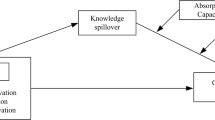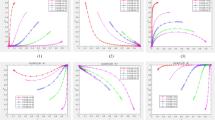Abstract
This paper takes the China’s A-share listed companies in the heavy pollution industry from 2010 to 2021 as the research sample and constructs a corresponding model to explore the existence, heterogeneity, and economic consequences of peer effect of green innovation. The results show that the enterprises’ green innovation not only has strategic behaviors of direct imitation, but also receives the environmental information disclosed by peer enterprises to correct their own decision-making; that is, there are two types of peer effects: imitation and reference. At the same time, the enterprises tend to imitate and learn from large-scale and high-quality enterprises with high governance level while making decisions on green innovation. External situational characteristics can moderate the peer effects of green innovation. The strengthening of intellectual property protection and the improvement of market competition will promote mutual learning and reference among enterprises, and the improvement of the institutional environment will inhibit the interaction of enterprises. Further analysis shows that the peer effect of imitation amplifies the promoting effect of green innovation on business performance, while the peer effect of reference does not show obvious spillover characteristics. The above analysis is helpful to reveal the more real decision-making motivation and potential driving mechanism for enterprises to take green innovation actions and provides new ideas and experience for green innovation to serve the development of entity enterprises.
Similar content being viewed by others
Data availability
Data are available from China Stock Market & Accounting Research Database and regular announcements of enterprises.
Notes
Ten specific indicators of environmental information disclosure include environmental protection investment, environmental protection financing, environmental protection training for employees, environmental accidents and problems, government subsidies and supervision, environmental agency certification, pressure from environmental policies, pollutant discharge and emission reduction, environmental improvement measures, and implementation of environmental protection concepts. See Xiang et al. (2020) for the corresponding keywords.
This paper does not show the estimated results of asymmetric peer effect with lag of 2–3 periods. If necessary, it can be obtained from the author.
References
Aerts W, Cormier D, Magnan M (2006) Intra-industry imitation in corporate environmental reporting: an international perspective. J Account Public Policy 25(3):299–331
Ai YH, Peng DY, Xiong HH (2021) Impact of environmental regulation intensity on green technology innovation: from the perspective of political and business connections. Sustainability 13(9):1–23
Anand J, Mesquita LF, Vassolo RS (2009) The dynamics of multimarket competition in exploration and exploitation activities. Acad Manage J 52:802–821
Ang JS, Cheng Y, Wu C (2014) Does enforcement of intellectual property rights matter in China? Evidence from financing and investment choices in the High-Tech industry. Rev Econ Stat 96(2):332–348
Barnett WP, Hansen MT (1996) The red queen in organizational evolution. Strateg Manag J 17(S1):139–157
Berrone P, Fosfuri A, Gelabert L, Luis R (2013) Necessity as the mother of ‘green’ inventions: institutional pressures and environmental innovations. Strateg Manag J 34(8):891–909
Chapman G, Lucena A, Afcha S (2018) R&D subsidies & external collaborative breadth: differential gains and the role of collaboration experience. Res Policy 47(3):623–636
Chen SL, Ma H (2017) Peer effects in decision-making: evidence from corporate investment. China J Account Res 10:167–188
Chen W, Pan LY, Lin CR, Wei X (2021) Efficiency evaluation of green technology innovation of China’s industrial enterprises based on SBM model and EBM model. Math Probl Eng 9:1–11
Cheng ZH, Wang F, Keung C, Bai YX (2017) Will corporate political connection influence the environmental information disclosure level? Based on the panel data of a-shares from listed companies in Shanghai stock market. J Bus Ethics 143(1):209–221
Gabaix X, Landier A (2008) Why has CEO pay increased so much. Q J Econ 123(1):49–100
Gompers P, Ishii J, Metrick A (2003) Corporate governance and equity prices. Q J Econ 118:107–155
Hamamoto M (2006) Environmental regulation and the productivity of Japanese manufacturing industries. Resour Energy Econ 28(4):230–311
Hambrick DC (2007) Upper echelons theory: An update. Acad Manage Rev 32(2):334–343
Hsieh KY, Tsai W, Chen MJ (2015) If they can do it, why not us? Competitors as reference points for justifying escalation of commitment. Acad Manage J 58(1):38–58
Iyer DN, Miller KD (2008) Performance feedback, slack, and the timing of acquisitions. Acad Manage J 51(4):808–822
Jiang TT, Ji PJ, Shi Y, Ye Z, Jin Q (2021) Efficiency assessment of green technology innovation of renewable energy enterprises in China: a dynamic data envelopment analysis considering undesirable output. Clean Technol Environ Policy 3:1–11
Kahneman D, Tversky A (1979) Prospect theory: an analysis of decision under risk. Econometrica 47(2):263–291
Leary MT, Roberts MR (2014) Do peer firms affect corporate financial policy. J Finance 69(1):139–178
Lewis BW, Walls JL, Dowell GWS (2014) Difference in degrees: CEO characteristics and firm environmental disclosure: research notes and commentaries. Strateg Manag J 35(5):712–722
Li V (2015) Do false financial statements distort peer firms’ decisions. Account Rev 91(1):251–278
Li HY, Atuahene-Gima K (2001) Product innovation strategy and the performance of new technology ventures in China. Acad Manage J 44(6):1123–1134
Li JT, Yao FK (2010) The role of reference groups in international investment decisions by firms from emerging economies. J Int Manag 16(2):143–153
Li G, Xue Q, Qin J (2022) Environmental information disclosure and green technology innovation: empirical evidence from China. Technol Forecast Soc Change 176:121453
Lieberman MB, Asaba S (2006) Why do firms imitate each other. Acad Manage Rev 31(2):366–385
Lin QM, Liu Q (2020) Analysis on the policy mechanism and optimization of green technology innovation in manufacturing industry——based on the data of listed companies in the new energy vehicle industry. IOP Conf Ser: Earth Environ Sci 510(3):1–6
Liu SB, Wu D (2016) Competing by conducting good deeds: the peer effect of corporate social responsibility. Finance Res Lett 16(6):47–54
Lu JW (2002) Intra-and inter-organizational imitative behavior: institutional influences on Japanese firms’ entry mode choice. J Int Bus Stud 33(1):19–37
Luo XWR, Wang DQ (2021) Are politically endorsed firms more socially responsible? Selective engagement in corporate social responsibility. J Bus Ethics 170(3):535–555
Manski C (2000) Economics analysis of social interactions. J Econ Perspect 14(3):115–136
March JG, Olsen JP, Christensen S (1976) Ambiguity and choice in organizations. Am J Sociol 79(1):128–140
Mcgrath RG, Macmillan CIC (1998) Multimarket maneuvering in uncertain spheres of influence: resource diversion strategies. Acad Manage Rev 23(4):724–740
Mohr LB, March JG, Olsen JP (1976) Ambiguity and choice in organizations. Am Polit Sci Rev 72(3):408–1035
Pacheco DF, Dean TJ (2015) Firm responses to social movement pressures: a competitive dynamics perspective. Strateg Manag J 36:1093–1104
Patrick I (2019) How to foster green product innovation in an inert sector. J Innov Knowl 4(2):129–138
Peng H, Shen N, Ying H, Wang Q (2021) Can environmental regulation directly promote green innovation behavior?——based on situation of industrial agglomeration. J Clean Prod 314:128044
Porter ME, Van Der Linde C (1995) Toward a new conception of the environment competitiveness relationship. J. Econ. Perspect. 9(4):97–118
Posen HE, Lee J, Yi S (2013) The power of imperfect imitation. Strateg Manag J 34:149–164
Ravichandran T (2018) Exploring the relationships between IT competence, innovation capacity and organizational agility. J Strateg Inf Syst 27(1):22–42
Semadeni M, Anderson BS (2010) The follower’s dilemma: innovation and imitation in the professional service industry. Acad Manage J 53:1175–1193
Shen L, Fan RJ, Wang YY, Tang RY (2020) Impacts of environmental regulation on the green transformation and upgrading of manufacturing enterprises. Int J Environ Res Public Health 17(20):1–14
Short JC, Broberg JC, Cogliser CC, Brigham KH (2010) Construct validation using computer-aided text analysis (CATA) an illustration using entrepreneurial orientation. Organ Res Methods 13(2):320–347
Smallwood DE, Conlisk J (1979) Product quality in markets where consumers are imperfectly informed. Q J Econ 93(1):1–23
Teece DJ (1986) Profiting from technological innovation: implications for integration, collaboration, licensing and public policy. Res Policy 15(6):285–305
Uzo U, Mair J (2014) Source and patterns of organizational defiance of formal institutions: insights from Nollywood, the Nigerian movie industry. Strateg Entrep J 8(1):56–74
Wang F, Feng LL, Li J, Wang L (2020) Environmental regulation, tenure length of officials, and green innovation of enterprises. Int J Environ Res Public Health 17(7):1–16
Wei LL, Zhang CL, Su JJ, Yang LX (2021) Panel threshold spatial Durbin models with individual fixed effects. Econ Lett 201(5–6):109778
Wu HQ, Liu SL, Hu SM (2021) Visible hand: do government subsidies promote green innovation performance——moderating effect of ownership concentration. Pol J Environ Stud 30(1):881–892
Xiang XJ, Liu CJ, Yang M, Zhao XM (2020) Confession or justification: the effects of environmental disclosure on corporate green innovation in China. Corp Soc Responsib Environ Manag 1:1–16
Zhang X, Xu B (2019) R&D internationalization and green innovation? Evidence from Chinese resource enterprises and environmental enterprises. Sustainability 11(24):1–18
Zhou M, Govindan K, Xie XB, Yan L (2021) How to drive green innovation in China’s mining enterprises? Under the perspective of environmental legitimacy and green absorptive capacity. Resour Policy 72:102038
Zhu XH, Zuo XG, Li HL (2021) The dual effects of heterogeneous environmental regulation on the technological innovation of Chinese steel enterprises ——based on a high-dimensional fixed effects model. Ecol Econ 188:107113
Acknowledgements
All tables and figures are made by the authors.
Funding
This work was funded by the following projects: National Natural Science Foundation of China (Project No.72073030).
Author information
Authors and Affiliations
Contributions
ZH conducted the quantitative analyses and composed the paper. YAZ guided the direction and ideas. All authors read and approved the final manuscript.
Corresponding author
Ethics declarations
Ethical approval
Not applicable.
Consent to participate
Not applicable.
Consent for publication
Not applicable.
Competing interests
The authors declare no competing interests.
Additional information
Responsible Editor: Eyup Dogan
Publisher's note
Springer Nature remains neutral with regard to jurisdictional claims in published maps and institutional affiliations.
Rights and permissions
Springer Nature or its licensor (e.g. a society or other partner) holds exclusive rights to this article under a publishing agreement with the author(s) or other rightsholder(s); author self-archiving of the accepted manuscript version of this article is solely governed by the terms of such publishing agreement and applicable law.
About this article
Cite this article
Zheng, H., Ye, A. Direct imitation or indirect reference?—research on peer effects of enterprises’ green innovation. Environ Sci Pollut Res 30, 41028–41044 (2023). https://doi.org/10.1007/s11356-023-25184-5
Received:
Accepted:
Published:
Issue Date:
DOI: https://doi.org/10.1007/s11356-023-25184-5




